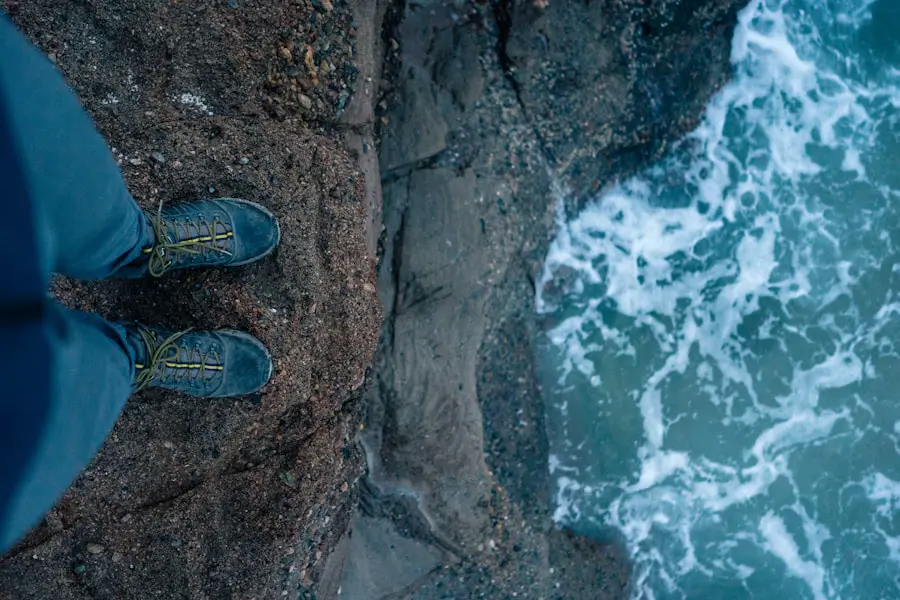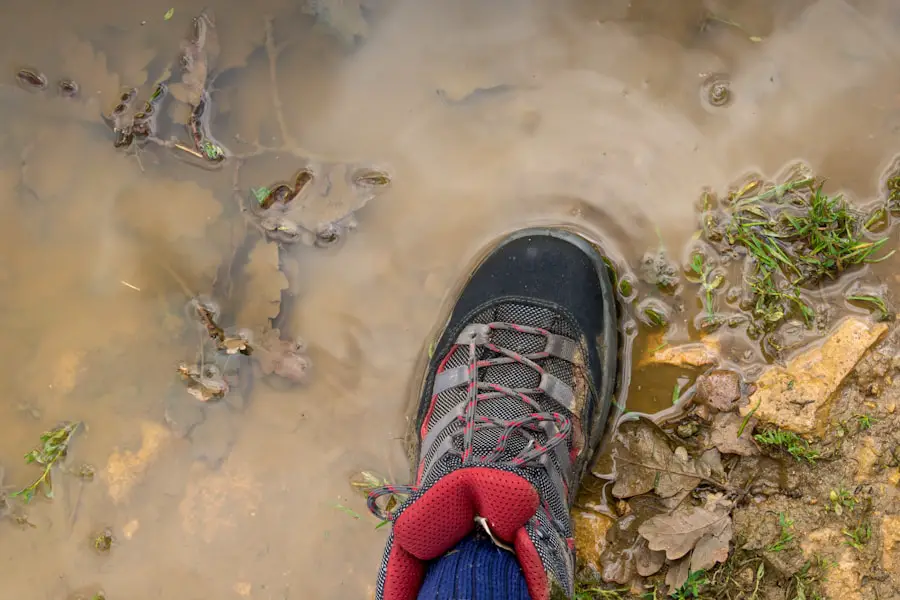When embarking on a hiking adventure, the choice of footwear can significantly impact the overall experience. Waterproof hiking shoes are essential for those who traverse diverse terrains and encounter unpredictable weather conditions. The primary function of these shoes is to keep your feet dry, which is crucial for maintaining comfort and preventing blisters.
Wet feet can lead to a host of issues, including fungal infections and discomfort that can ruin an otherwise enjoyable hike. Therefore, investing in a quality pair of waterproof hiking shoes is not merely a matter of preference; it is a necessity for serious hikers. Moreover, waterproof hiking shoes provide a layer of protection against the elements, allowing hikers to confidently navigate through streams, muddy trails, and rainy conditions.
The psychological comfort that comes from knowing your feet are shielded from moisture can enhance your overall hiking experience. This assurance allows hikers to focus on the beauty of their surroundings rather than the discomfort of wet socks or cold feet. In essence, waterproof hiking shoes serve as a critical barrier between the hiker and the often harsh realities of nature, making them an indispensable part of any outdoor enthusiast’s gear.
Key Takeaways
- Waterproof hiking shoes are important for keeping your feet dry and comfortable, especially in wet and muddy conditions.
- Consider the terrain and weather conditions of your hiking destination when choosing waterproof hiking shoes to ensure they provide the necessary protection and support.
- The benefits of waterproof hiking shoes include protection from water, mud, and debris, as well as added insulation and warmth in cold and wet conditions.
- Drawbacks of waterproof hiking shoes may include reduced breathability and potential for trapped moisture, leading to discomfort and blisters.
- Alternatives to waterproof hiking shoes include breathable trail running shoes or non-waterproof hiking shoes for dry and warm conditions.
Terrain and Weather Considerations
The terrain and weather conditions play a pivotal role in determining the necessity of waterproof hiking shoes. For instance, if you plan to hike in areas known for their wet climates, such as the Pacific Northwest or during the rainy season in tropical regions, waterproof footwear becomes essential. These shoes are designed to withstand prolonged exposure to moisture, ensuring that your feet remain dry even when traversing through puddles or muddy paths.
Additionally, in mountainous regions where snow and ice are prevalent, waterproof shoes can provide the necessary insulation and protection against cold, wet conditions. Conversely, in arid environments or during dry seasons, the need for waterproof shoes may diminish. However, even in these scenarios, unexpected rain showers or stream crossings can occur, making waterproof features beneficial.
The versatility of waterproof hiking shoes allows them to adapt to various terrains, from rocky trails to sandy beaches. Understanding the specific conditions you will encounter on your hike is crucial in making an informed decision about your footwear. This consideration not only enhances comfort but also ensures safety as you navigate through challenging landscapes.
Benefits of Waterproof Hiking Shoes

The advantages of waterproof hiking shoes extend beyond mere dryness; they encompass a range of features that enhance performance and comfort. One significant benefit is the ability to maintain temperature regulation within the shoe. Waterproof materials often come with breathable membranes that allow moisture from sweat to escape while preventing external water from entering.
This balance helps keep your feet dry from both external sources and internal perspiration, reducing the risk of overheating during strenuous hikes. Another notable benefit is the durability that often accompanies waterproof hiking shoes. Many models are constructed with robust materials designed to withstand harsh conditions and rough terrains.
This durability translates into longevity, making them a worthwhile investment for avid hikers. Additionally, many waterproof shoes feature reinforced toe caps and sturdy outsoles that provide traction on slippery surfaces, enhancing safety during treks through wet or uneven ground. The combination of comfort, protection, and durability makes waterproof hiking shoes an attractive option for those who frequently explore the great outdoors.
Drawbacks of Waterproof Hiking Shoes
| Drawback | Description |
|---|---|
| Lack of Breathability | Waterproof hiking shoes can trap heat and moisture, leading to sweaty and uncomfortable feet. |
| Longer Drying Time | Once waterproof hiking shoes get wet, they can take longer to dry compared to non-waterproof options. |
| Heavier Weight | Waterproof materials can add extra weight to the shoes, making them less ideal for long hikes or backpacking trips. |
| Less Flexibility | Some waterproof membranes can reduce the flexibility of the shoes, impacting natural foot movement. |
Despite their numerous advantages, waterproof hiking shoes are not without their drawbacks. One significant concern is breathability. While many waterproof models incorporate breathable membranes, they may not be as effective as non-waterproof alternatives in allowing heat and moisture to escape.
This can lead to sweaty feet during long hikes, which may counteract some of the benefits of having dry footwear. Hikers who prioritize breathability may find themselves compromising on comfort when choosing waterproof options. Another potential drawback is weight.
Waterproof hiking shoes often incorporate additional materials and technologies to achieve their water-resistant properties, which can result in a heavier shoe compared to non-waterproof models. For those who prioritize lightweight gear for speed and agility on the trail, this added weight may be a significant consideration. Furthermore, waterproof shoes can sometimes come at a higher price point due to the specialized materials used in their construction.
Hikers on a budget may find it challenging to justify the investment when there are less expensive alternatives available.
Alternatives to Waterproof Hiking Shoes
For those who may find waterproof hiking shoes unsuitable for their needs or preferences, several alternatives exist that can still provide adequate protection and comfort on the trail. One popular option is water-resistant hiking shoes or trail runners. These models typically feature water-repellent materials that offer some level of protection against moisture without being fully waterproof.
They are often lighter and more breathable than their waterproof counterparts, making them ideal for warm-weather hikes or less challenging terrains. Another alternative is traditional hiking boots made from leather or synthetic materials that offer good water resistance but may not be entirely waterproof. These boots can provide excellent ankle support and durability while allowing for better breathability compared to fully waterproof models.
Additionally, some hikers opt for gaiters—protective coverings worn over shoes and lower legs—to keep water and debris out while wearing non-waterproof footwear. This combination allows for flexibility in choosing lighter shoes while still providing some level of protection against wet conditions.
Choosing the Right Waterproof Hiking Shoes

Assessing the Type of Hiking
First and foremost, it is essential to assess the type of hiking you plan to undertake. For rugged terrains with steep inclines or rocky paths, a shoe with excellent ankle support and a sturdy outsole is crucial. Conversely, if you primarily hike on well-maintained trails or prefer lighter footwear for speed, trail runners with waterproof features may be more suitable.
Fitting the Right Shoe
Fit is another critical factor when choosing waterproof hiking shoes. It is advisable to try on multiple pairs while wearing the socks you intend to use during hikes to ensure a proper fit. A well-fitting shoe should provide enough room in the toe box while securely holding the heel in place to prevent blisters during long treks.
Additional Considerations
Additionally, consider the shoe’s weight and breathability based on your hiking style and climate conditions. Researching customer reviews and expert recommendations can also provide valuable insights into specific models’ performance and durability.
Maintenance and Care of Waterproof Hiking Shoes
Proper maintenance and care are vital for prolonging the life of your waterproof hiking shoes and ensuring they perform optimally over time. After each hike, it is essential to clean your shoes thoroughly to remove dirt, mud, and debris that can compromise their waterproof capabilities. Use a soft brush or cloth along with mild soap and water to clean the exterior surfaces gently.
Avoid using harsh chemicals or abrasive materials that could damage the shoe’s materials. Additionally, reapplying a water-repellent treatment periodically can help maintain the shoe’s waterproof properties. Many manufacturers offer sprays or waxes specifically designed for this purpose.
It is advisable to follow the manufacturer’s instructions regarding application frequency and methods. Storing your shoes in a cool, dry place away from direct sunlight will also help preserve their integrity over time. By taking these steps, you can ensure that your waterproof hiking shoes remain effective and comfortable for many adventures ahead.
Making the Decision for Your Hiking Needs
In conclusion, selecting the right footwear for hiking is a decision that requires careful consideration of various factors including terrain, weather conditions, personal preferences, and maintenance requirements. Waterproof hiking shoes offer significant benefits such as keeping feet dry and providing durability against harsh elements; however, they also come with drawbacks like potential breathability issues and added weight. Understanding these aspects will empower hikers to make informed choices tailored to their specific needs.
Ultimately, whether you opt for waterproof hiking shoes or explore alternatives like water-resistant models or traditional boots depends on your unique hiking style and environment. By weighing these factors thoughtfully and considering how they align with your outdoor pursuits, you can ensure that your footwear enhances rather than hinders your adventures in nature.
When deciding whether or not you need waterproof hiking shoes for your next adventure, it’s important to consider the terrain and weather conditions you’ll be facing. According to a recent article on TakeTravelInfo, having the right footwear can make all the difference in your hiking experience. Whether you’re trekking through wet and muddy trails or crossing streams, waterproof hiking shoes can help keep your feet dry and comfortable throughout your journey.
FAQs
What are waterproof hiking shoes?
Waterproof hiking shoes are footwear designed to keep your feet dry and comfortable while hiking in wet or damp conditions. They are typically made with waterproof materials such as Gore-Tex or eVent to prevent water from seeping into the shoes.
Do I need waterproof hiking shoes?
Whether or not you need waterproof hiking shoes depends on the type of hiking you plan to do and the conditions you expect to encounter. If you will be hiking in wet or muddy terrain, crossing streams, or hiking in rainy weather, waterproof hiking shoes can provide added protection and comfort for your feet.
What are the benefits of waterproof hiking shoes?
The benefits of waterproof hiking shoes include keeping your feet dry and comfortable in wet conditions, providing protection from water, mud, and moisture, and reducing the risk of blisters and discomfort during long hikes.
Can I use regular hiking shoes instead of waterproof ones?
Regular hiking shoes may be suitable for dry conditions or shorter hikes, but if you anticipate encountering wet or muddy terrain, waterproof hiking shoes can provide better protection and comfort for your feet.
Are there any drawbacks to waterproof hiking shoes?
Some drawbacks of waterproof hiking shoes include reduced breathability compared to non-waterproof shoes, potential for heat and moisture buildup inside the shoes, and the added cost compared to non-waterproof options.
